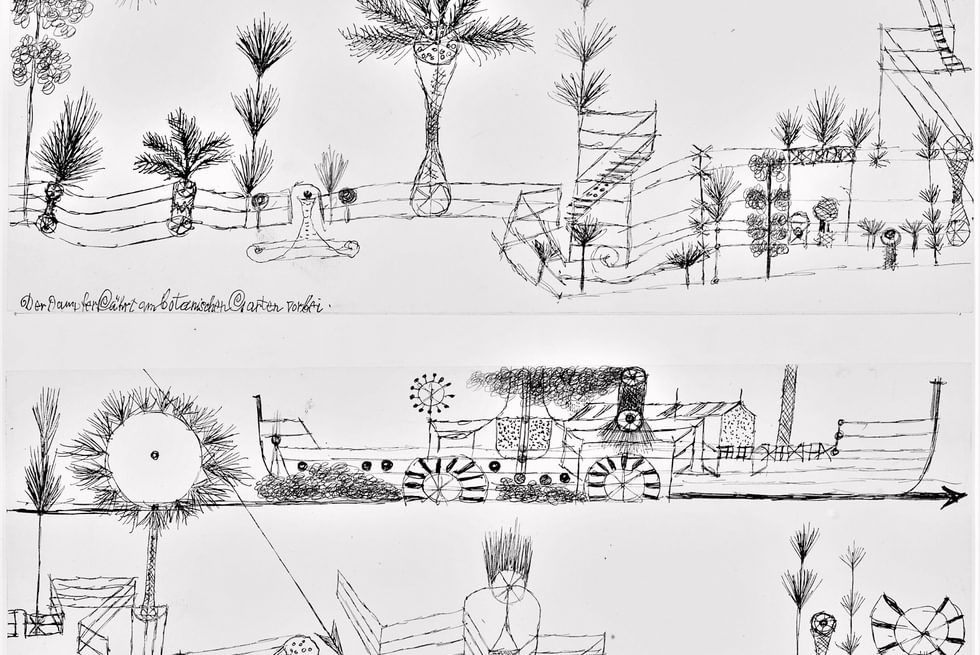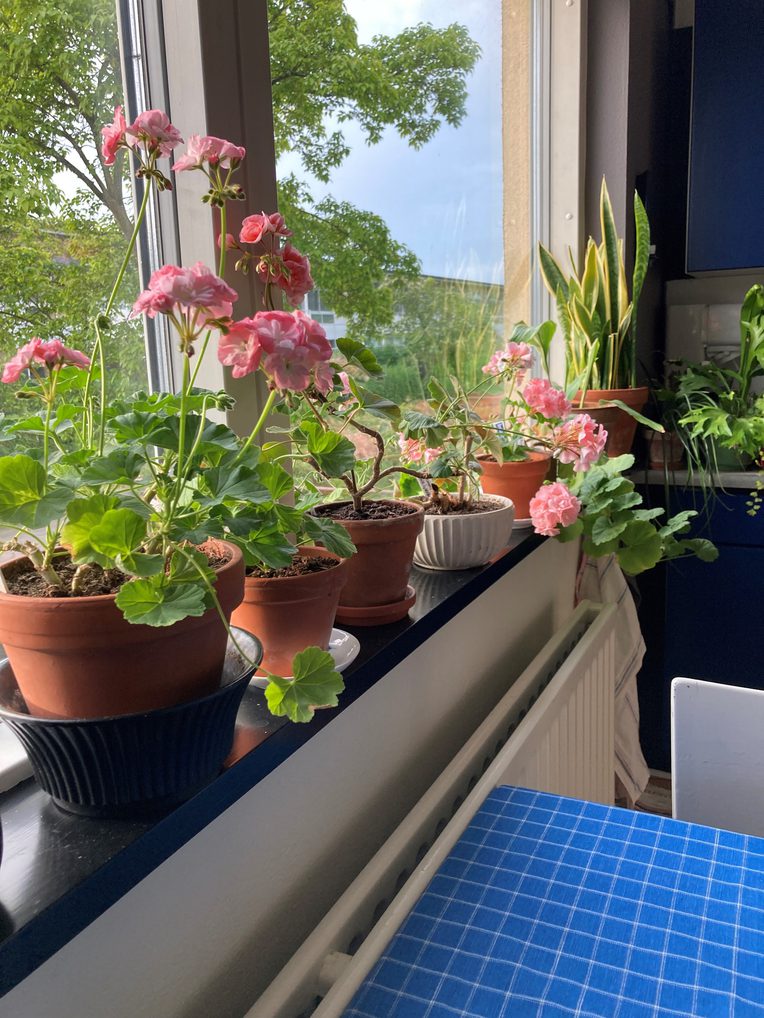Colonial Glasshouse Effects
From the Series: Plantationocene
From the Series: Plantationocene

Across the colder, wealthier parts of the world, “houseplants” adapted to warmer climes have become deeply engrained in people’s everyday lives, moving between homes, friends, and relatives. Yet they pose potentially unsettling questions: How and why have they made their way to where they are suited to the warmth of indoor environments, but not the surrounding climatic conditions? In what ways do these plants’ indoor worlds—our homes—carry forward such processes? What might such stories tell us about the era that some are calling the “Plantationocene”?
The role of technology within broader social processes offers some clues. In the late 1400s, the first documented seeds and bulbs were collected by Europeans in newly “discovered” territories (Mgbeoji 2014). By the end of the 1800s, many of today’s popular houseplants—including Pelargoniums (Fig. 1)—had made their way to Europe (Boddy 2013). From London to Copenhagen, plants were housed in orangeries and glasshouses as displays of knowledge and wealth; or as commodities, such as coffee, under early glasshouse production (Pendergrast 2010). Indeed, glasshouses served as cocoons by which plants could be transported (Ward 1852), tested, and “improved” during their transformation from colonial plunder to plantation-produced commodity (Keogh 2022). As technologies like indoor heating and larger, clearer glass became cheaper, especially during the 1900s, it became possible for a broader swathe of the middle-classes to emulate in their own windowsills the grand plant displays of the rich (T. Martin 1988). These technologies became cheaper during the twentieth century and exotic houseplants found their way into the homes of all classes.

Less often considered in literature focusing on human-plant relationships are ways in which such technologies, surely linked to human needs, were first developed in response to the life processes of plants. This includes perhaps the most famous glass structure in history, the Crystal Palace (Fig. 2), built in 1851 in London’s Hyde Park. Designed to exemplify the light and airy home of the future, and hawking the “works of industry of all nations” (especially Britain’s colonies), the Palace was “the first large-scale attempt to transition . . . greenhouse-derived architecture into something habitable for people as well as plants” (Eskilson 2018, 162). While glass technology’s journey from the Crystal Palace to every home was far from direct, this was a powerful moment associating modernity, glass, and light. Going further, Peter Sloterdijk (probably rightly) sees capitalism encapsulated by the Crystal Palace as metaphor, “a hothouse that has drawn inwards everything that was once on the outside . . . [where] the meaning of freedom is exposed in the ability to choose between products for the market—or to create . . . products oneself” (2013, 12). We will return to this.

Turning to warmth, at least two main modern forms of home central heating—heated air and water—saw key developments in early glasshouse technology. Fire stoves were typically either placed in with the plants themselves, or smoke was encouraged to flow under glasshouse floors. Early glasshouse designer John Evelyn (1620–1706) noted the harms suffered by plants exposed to leaking smoke, unable to “breathe, the pure and genuine Air” (Laird 2006, 158). He proposed placing stoves outside, and, instead of smoke, using piped warmed air. While warmed air would later become one of the main methods of heating all manner of buildings, it was not always an ideal solution for glasshouses. Air does not hold its warmth for long and furnaces had to be kept continuously burning—expensive in fuel and manpower—while sudden temperature drops were deadly for tropical plants. Hot water based heating systems offered potential solutions to both these problems, with their use reported in the 1700s in the Jardin des Plantes, Paris (Loudon 1828, iii). By the 1800s, hot water was becoming increasingly popular in northern Europe, and in some cases was used to warm wealthy private homes (Loudon 1828, 186, 191, 367, 432). Again, the journey from glasshouse to every home was far from direct, with most homes in Britain, for example, relying on open fireplaces well into the twentieth century (Marshall et al. 2021). Nevertheless, these were key developments of technologies many in northern climes find in their homes today.
As the last few years have made excruciatingly clear, humans are beings composed across manifold species, forms, and scales. Houseplants can help anthropologists think through this, tying in tangible ways the intimate multispecies spaces of home to planet-altering plantation ecologies. Beyond this, the processes sketched above suggest that our understanding of the planty multispecies homes through which we become might go beyond the various species currently inhabiting those spaces with us, beyond fuels, foods, and building materials. It might also encompass the “ghosts” of colonial encounters, finespun into the forms of our homes themselves (Tsing, Mathews, and Bubandt 2019).
And yet, ghosts are unsettling less as emanations from the past, and more through their hold on the present. Returning to the Crystal Palace metaphor, interiorization in warmth, glass, and light might be seen as the comfortable mutually dependent sibling twin of enclosures intrinsic to plantation and factory processes of production. If the Palace encompasses our homes, which have become primary sites of consumption and production, it’s not only that each twin needs the other for its existence, but that they share in a foundational logic. Home comforts won by the masses have profited both the public and private wings of capital: cultivating more healthy and indebted workers (Harvey 2018), interiorizing populations as legible subjects (Scott 1998), creating markets for (plantation-produced) goods, and constituting a significant share of “advanced” economies (Weinstock 2021). Half of a percentage of the world's ice-free surface is covered by the indoor biome (Martin et al. 2015). A significant proportion of this will be homes haunted by colonial glasshouse specters and inhabited by their profitable “products”: human beings. Such buildings and their warming technologies are, of course, also a primary source of greenhouse gas emissions.
Despite similarities and dependencies, the systems we live under require that our homes are not exactly plantations. We must consume as well as produce. Plantations might be better understood as part of wider processes whereby the logic of interiorizing people, landscapes, and the world expresses itself in an array of deeply interwoven forms. Perhaps the plantation is rather one such key, profoundly localizing figure through which we can grasp just what is going on at this unsettling moment.
Boddy, Kasia. 2013. Geranium. London: Reaktion Books.
Eskilson, Stephen. 2018. The Age of Glass: A Cultural History of Glass in Modern and Contemporary Architecture. London: Bloomsbury Publishing.
Foucault, Michel. 2007. Security, Territory, Population: Lectures at the College de France 1977-1978. London: Palgrave.
Gertel, Jörg and Sarah Ruth Sippil. 2014. Seasonal Workers in Mediterranean Agriculture. The Social Costs of Eating Fresh. New York: Routledge.
Gallo, Emanuelle. 2008. "Lessons Drawn from the History of Heating: A French Perspective." In The Culture of Energy, edited by Rüdiger Mogens, 268–80. Newcastle: Cambridge Scholars Publishing.
Harvey, David. 2018. "Universal Alienation." Journal for Cultural Research 22, no. 2: 137–50.
Keogh, Luke. 2022. The Wardian Case: How a Simple Box Moved Plants and Changed the World. Chicago: University of Chicago Press.
Laird, Mark. 2006. "'Perpetual Spring' or Tempestuous Fall: The Greenhouse and the Great Storm of 1703 in the Life of John Evelyn and His Contemporaries." Garden History 34, no. 2: 153–73.
Loudon, J. C. 1828. The Gardener’s Magazine, and Register of Rural and Domestic Improvement. Vol. 3. London: Longman, Rees, Orme, Brown, and Green.
Marshall, Duncan, Derek Worthing, Nigel Dann, and Roger Heath. 2021. Marshall and Worthing’s the Construction of Houses. New York: Routledge.
Martin, Laura J., Rachel I. Adams, Ashley Bateman, Holly M. Bik, John Hawks, Sarah M. Hird, David Hughes, et al. 2015. "Evolution of the Indoor Biome." Trends in Ecology & Evolution 30, no. 4: 223–32.
Martin, Tovah. 1988. Once upon a Windowsill: A History of Indoor Plants. Madison, Wis.: Timber Press.
Mgbeoji, Ikechi. 2014. Global Biopiracy: Patents, Plants, and Indigenous Knowledge. Vancouver: University of British Columbia Press.
Pendergrast, Mark. 2010. Uncommon Grounds: The History of Coffee and How It Transformed Our World. New York: Basic Books.
Scott, James C. 1998. Seeing Like a State: How Certain Schemes to Improve the Human Condition Have Failed. New Haven: Yale University Press.
Skuncke, Marie-Christine. 2014. Carl Peter Thunberg, Botanist and Physician: Career-Building across the Oceans in the Eighteenth Century. Uppsala, Sweden: Swedish Collegium for Advanced Study.
Sloterdijk, Peter. 2013. In the World Interior of Capital: Towards a Philosophical Theory of Globalization. London: Polity.
Tsing, Anna Lowenhaupt, Andrew S. Mathews, and Nils Bubandt. 2019. "Patchy Anthropocene: Landscape Structure, Multispecies History, and the Retooling of Anthropology: An Introduction to Supplement 20." Current Anthropology 60, S20: S186–97.
Ward, Nathaniel Bagshaw. 1852. On the Growth of Plants in Closely Glazed Cases. London: J. Van Voorst.
Weinstock, Lida R. 2021. "Introduction to U.S. Economy: Housing Market."